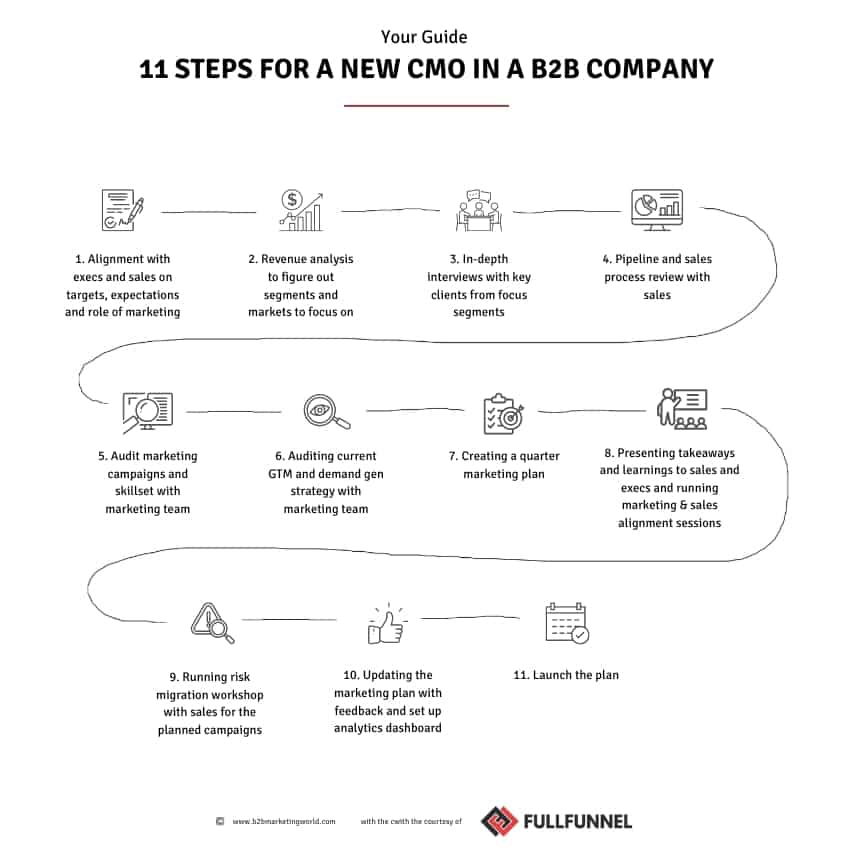Table of Contents
- 1. Alignment with execs and sales
- 2. Revenue Analysis
- 3. In-depth Client Interviews
- 4. Sit down with sales:
- 5. Sit down with Marketing:
- 6. GTM and Demand Gen Strategy Audit
- 7. Create a Quarter Marketing Plan
- 8. Present Takeaways and Learnings
- 9. Risk mitigation Workshop with Sales
- 10. Update the Marketing Plan
- 11. Launch the Plan
- Summary
Subscribe to our Newsletter and Learn B2B Marketing.
In this guide, I’m going to share with you 11 steps to take in the first 90 days of your B2B CMO job if you join a B2B company with a high ACV product.
As a new chief marketing officer in a B2B company, it’s important to hit the ground running and establish a strategy for aligning marketing and sales efforts.
I outline a step-by-step plan for how to do just that. By following this plan, you’ll be able to establish a strong foundation for aligning marketing and sales efforts in your B2B company in the first 90 days of your tenure as CMO.
1. Alignment with execs and sales
Align with executives and sales on the following 4 topics:
- Targets (and analyzing the data to see if these targets are realistic)
- Challenges we are currently facing in achieving these goals
- Marketing role in the organization & expectations
- Metrics to measure marketing efficiency
Few points here.
You need to have an honest conversation with executives about expectations from marketing and the role of marketing and current challenges.
For example:
- Your product is unknown, and nobody wants to buy it
- Prospects don’t understand product value
- Sales don’t understand the buyer’s journey and needs, etc.
Both senior leadership, sales, and marketing should accept them and create programs to solve the challenges.
Next, just because a company raised money doesn’t mean you can set up unrealistic goals.
Having more budget ≠ generating more revenue if the company challenges from the previous step were not solved, and your company doesn’t have proven marketing frameworks.
Next, metrics.
Demand or brand activities can’t be measured by sales opportunities or CAC.
Hence, I recommend holistically looking at marketing-sourced revenue, sales pipeline velocity, and budget spent to calculate marketing ROI.
We cover B2B Marketing reporting in detail in the GTM strategy guide.
2. Revenue Analysis
Run a revenue analysis to figure out:
- What geo markets generate the highest revenue, where is the highest ACV, win rate, and where is the sales cycle shorter
- The same analysis for market segments
- Defining key clients in these segments
3. In-depth Client Interviews
The third step is to run in-depth interviews with selected clients to figure out the following:
- What’s the value they are getting from our product, and how do they see it’s different from the competition?
- What triggered their buying process?
- How were they searching for our product, and who was involved in the decision-making process?
- What channels do they use?
- What questions and concerns do they have when evaluating different vendors?
These questions are crucial to understanding the buyer journey and aligning your marketing and sales with it.
And other questions to understand better the buying process.
4. Sit down with sales:
Next, sit down with sales and discuss the following:
- Challenges and bottlenecks they are currently facing in the prospecting and sales processes,
- What kind of help do they expect from marketing
- Defining the days for the regular pipeline review
- Analyzing recent won and lost deals
5. Sit down with Marketing:
After your sales meetings, start alignment with the marketing team over these topics:
- Challenges and bottlenecks they are currently facing in awareness, demand gen, and demand capturing campaigns
- What kind of help do they need from sales
- Auditing recent marketing campaigns and figuring out the setup of successful campaigns
- Figuring out the reasons for failed campaigns
- Evaluating skillset and career expectations
- Auditing current marketing processes and figuring out areas for improvement
6. GTM and Demand Gen Strategy Audit
The sixth step is to audit your current GTM and demand gen strategy with your marketing team, including these two steps:
- Aligning marketing activities with the buying journey to influence the full funnel with existing resources and skillset
- Highlighting the weakest full funnel stage
7. Create a Quarter Marketing Plan
Your marketing plan for the next quarter needs to cover:
- Pilot, small-scoped campaigns with a detailed playbook
- Clear goals and objectives
- Leading indicators to measure campaign progress
- Tying leading indicators to revenue
- Defining a minimal tech stack for pilot campaigns
I recommend considering a few points here.
A. Switch from marketing plans to growth sprints and operations.
If you launch a new campaign, avoid massive launches. You do it for the first time and can easily lose trust in marketing.
Start by adding small-scoped campaigns to your regular marketing operations. When you see enough traction, operationalize it and add it to your operations.
Start with 5-6 weeks sprints, 1-2 team members, and 1 market to validate the campaign and get the market feedback fast. Almost every pilot campaign is all about learning that you can use to refine it.
B. Set up clear, measurable goals and outcomes
For every pilot campaign, try to make a basic revenue forecast and ROI. But also make sure to add qualitative outcomes.
E.g., improved brand recognition measured by traffic from target accounts and media invites, which leads us to the next point.
C. Define leading indicators
Not all marketing campaigns and activities can be directly attributed to revenue, but it doesn’t mean they should be measured.
Define leading indicators and get everybody aligned.
Examples:
- ABM: # of connections with buying committee members.
- Thought leadership: # of chats about your product, brand mentions, media invites
- Awareness: # of views/clicks from target accounts
D. Create a detailed campaign timeline with the tasks, video explanation, and worksheets for team onboarding
Demand gen is not about showing up consistently and sharing random content on social media.
ABM is not about making a list of accounts and sending semi-personalized emails or direct mails.
Show:
- Step-by-step plan that highlights leading indicators and targets
- Guidelines and training for sales
- Tasks, responsibilities and involvement of every team member who’ll be involved in the campaign
- Revenue forecast or sales pipeline velocity
8. Present Takeaways and Learnings
Start presenting takeaways and learnings to sales and execs. Running marketing and sales alignment sessions on the following:
- Market segments to focus on
- ICP (Ideal customer profile), including account qualification criteria
- Value proposition hypotheses and amplifiers
9. Risk mitigation Workshop with Sales
The ninth step is to run a risk mitigation workshop with sales to figure out details about:
- Benefits they see from launching the campaigns
- Risks and concerns
- Run together risk mitigation ideas for the biggest concerns
10. Update the Marketing Plan
Update your marketing plan with feedback:
- Update playbook and timeline
- Set up clear tasks and onboard everybody who is involved Set up tracking dashboard and stack
11. Launch the Plan
The real marketing and sales alignment happens not on paper but when B2B marketers jump into the trenches with sales and help with generating revenue.
Summary
As a CMO of a B2B company, you want to nail your first 90 days. This is what you want to do.
Your plan to success includes steps such as having honest conversations with executives about marketing expectations and challenges, analyzing revenue data to identify key markets and clients, conducting in-depth interviews with clients to understand the buyer journey, and sitting down with sales and marketing teams to discuss challenges and areas for improvement.
The plan also includes creating a quarterly marketing plan with clear goals, objectives, leading indicators, and a detailed campaign timeline. Your efforts conclude with steps for presenting takeaways and learnings to sales and execs, running risk mitigation workshops, updating the marketing plan with feedback, and launching the plan.
11 Steps CMO Guide © B2B Marketing World with the Courtesy of Fullfunel
You May Like the Following Articles
B2B Agricultural Machinery Marketing
Selling tractors, harvesters, or plows isn’t a quick process. Buyers take time, involve multiple decision-makers, and require a solid financial commitment. This is a full guide on B2B agricultural machinery marketing, including real-world examples from John Deere and Kubota.
B2B Construction Machinery Marketing
This is your guide to create a B2B marketing construction machinery roadmap + 3 Examples. Marketing in the construction machinery industry is complex but essential. Unlike consumer goods, purchasing decisions for heavy equipment like excavators, bulldozers, and loaders involve multiple stakeholders, long sales cycles and significant investments. This article provides a structured approach to B2B marketing for the construction machinery industry.
B2B Fintech Marketing
B2B fintech marketing promotes financial technology products to other businesses. It’s different from consumer marketing because the target group is companies like banks, insurance firms, and financial institutions. In this article, we explore the foundations of B2B fintech marketing. We look at key strategies, challenges, and how to measure success. We also discuss future trends that will shape this industry.
B2B Manufacturing Marketing
B2B manufacturing marketing involves promoting products and services from one business to another within the manufacturing sector. Key Points are: Complex Buying Process, Emphasis on Relationships, Technical Focus. This blog post will explore the unique aspects of B2B manufacturing marketing, its challenges, and effective strategies for overcoming them.
Build a B2B Marketing Funnel
Build a B2B marketing funnel requires 5 steps: creating a customer journey, mapping marketing channels, building a multi-touch attribution model, establishing and measuring KPIs, and constantly adapting the funnel. Read how to do this and learn that marketing and sales alignment are essential.
B2B vs B2C Marketing
B2B marketing focuses on marketing strategies, tactics, and content tailored to promote products or services to other businesses. On the other hand, B2C marketing uses strategy and tactics to market directly to consumers. B2B and B2C marketing share similar principles but differ in various aspects.










